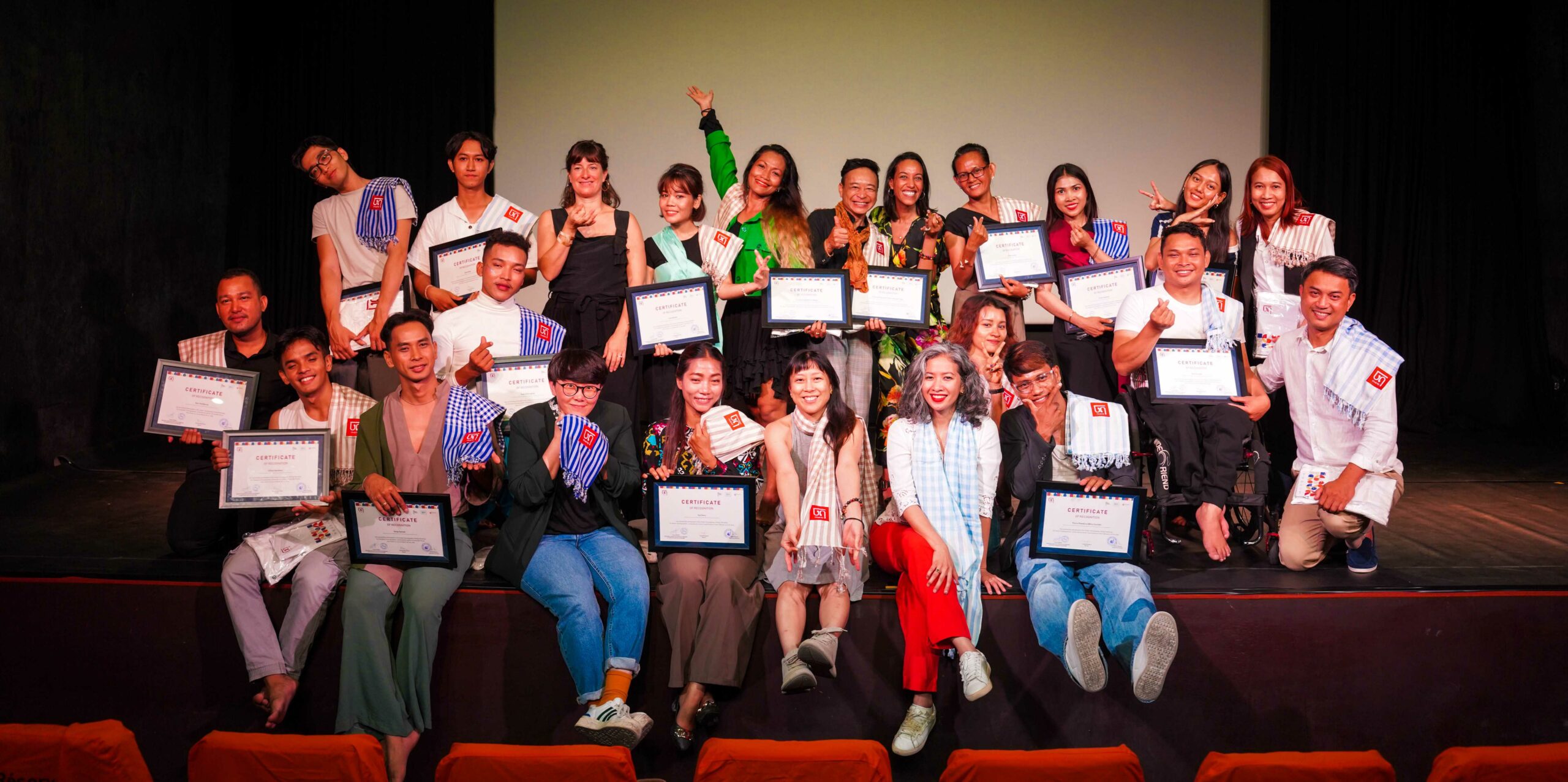On an April afternoon at the Institut français du Cambodge’s theatre, choreographers step into shafts of multicoloured light. Their movements were raw, beautiful, and imperfect. It was the culmination of weeks of the Chakto Program’s Choreography Writing Workshop, now arriving at its most promising moment: ten of them were pitching their ideas, stories, and realities. Five were selected for grants, but all ten had already made their mark on Cambodia’s evolving contemporary dance narrative.
Weeks before the pitch, emerging and established Cambodian choreographers gathered to exchange ideas across generations through the workshops. Guiding them were two acclaimed international mentors: Emmanuèle Phuon, a French-Cambodian dancer, choreographer, and educator known for her work with Yvonne Rainer and the Baryshnikov Arts Center, and Fouad Boussouf, a French-Moroccan choreographer and artistic director of Le Phare, whose works blend hip hop with North African ritual and contemporary movement.
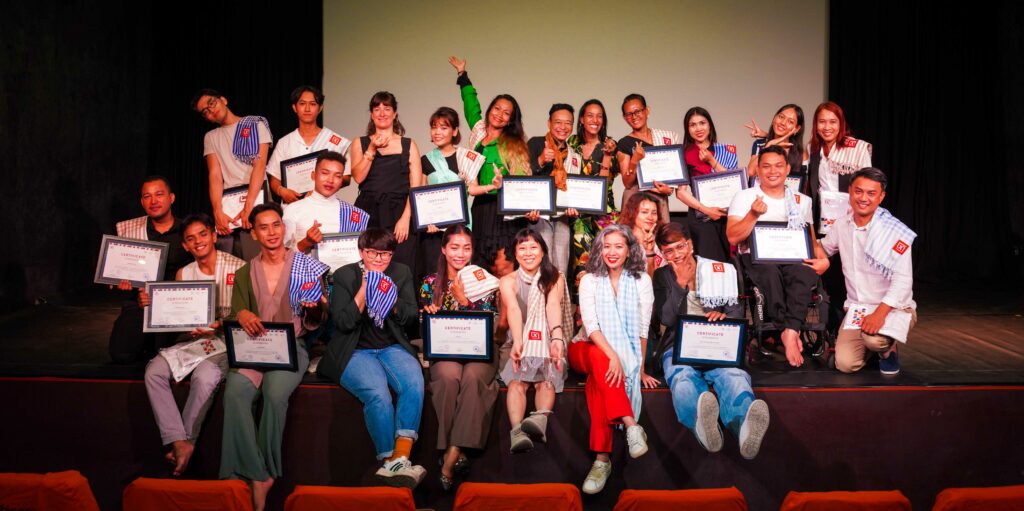
“Manou (Emmanuèle Phuon) guided us through intentional movement, not randomness,” said choreographer Pum Molyta, one of five grant recipients. “She was supportive, making everything feel simple and approachable.”
Awardee Kim Socheat added, “From Manou, I understand that we are not just performers, but creators. Likewise, audiences are not just viewers—they want to engage and perform with us. I’d never heard of this approach before, and it fascinated me.”
The five awardees will present their full-length pieces this October. Here are their stories:
Pak Din – Fine Embroidery, Fine Endurance
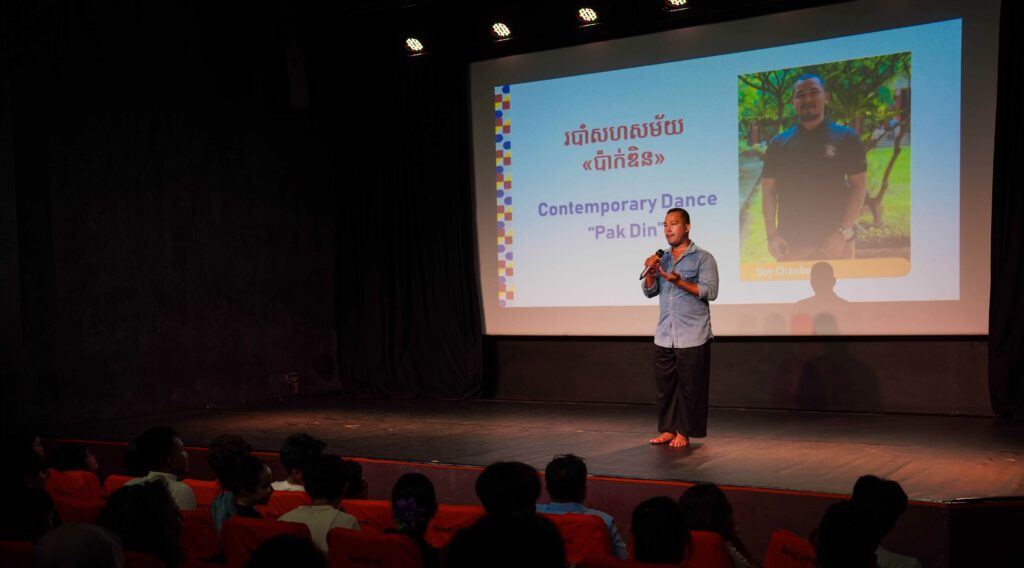
Soy Chanborey is softspoken, but his movements aren’t. Pak Din is a tribute to Cambodia’s unsung backstage legends: costume designers, mask makers, and older artists, whose names often go unheard.
“I want people to respect these artists like we respect traditional masks,” he said.
Trying embroidery himself, Borey discovered firsthand its demands: patience, focus, and endurance. His 30-minute solo isn’t about perfection—it’s about reverence. His background in Lakhon Khol and insight from the workshop influenced his approach.
“At the end of the show, I want people to feel the sweat,” he says. “With the sweat coming from my movement, I want audiences to sense the physical and emotional labor behind every stitch.”
While reflecting on the workshop, he noted, “Contemporary art isn’t about achieving perfection or pleasing everyone. It’s about expressing our own creative thinking, shaped by context, time, and space from which our art emerges.”
Home? – The Finding of Safe Space
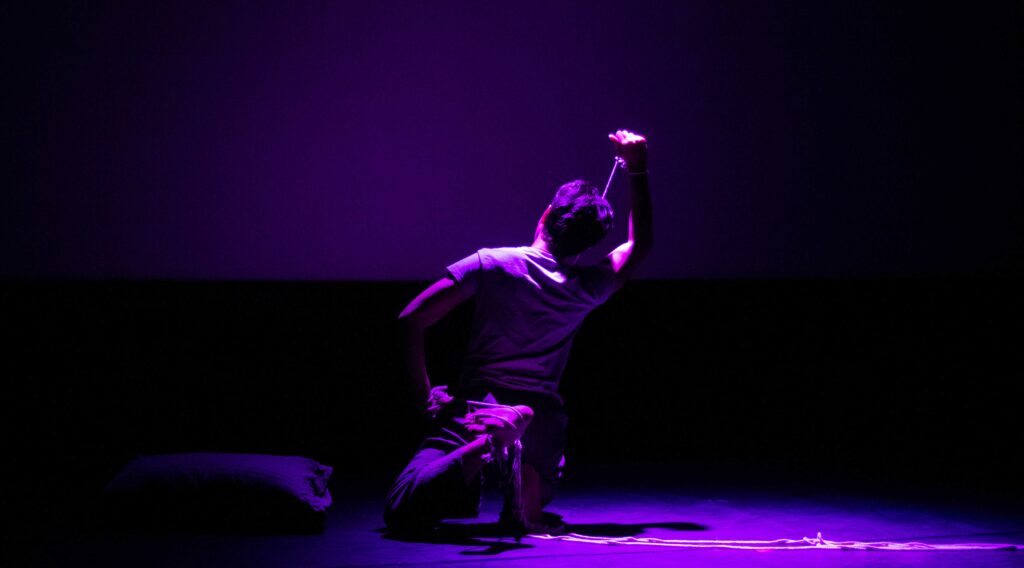
Dy Puthik’s work Home? unearths trauma, queerness, and emotional safety. With roots in Khmer classical dance and years of experience with Cambodia’s pioneering gay dance company, Prumsodun Ok & NATYARASA, Puthik brings vulnerability to the forefront of his art.
“Every family carries trauma differently,” Puthik said. “In mine, it showed up as silence. My parents, shaped by their childhood during the Khmer Rouge, raised me without intimacy that they, too, never received.”
His choreography begins with a visualized bedroom scene. Puthik lies on a pillow, symbolizing a safe space that gradually unravels into a haunting reflection on intergenerational pain. Home? explored the process of healing and the search for identity, of what it means to be queer in post-war Cambodia, where queer experiences are shaped by unique histories of conflict and survival.
The title was inspired by his friend who, after dancing, was told for the first time, “You are beautiful.” “That’s what dance can do—it can be the moment someone feels truly seen,” Puthik said. “This story stayed with me and stirred a quiet question: What is home, really? Is it the place we sleep, or the place we’re seen? For me, home is wherever we feel safe.”
Shadow – A brave step toward Her Own Light
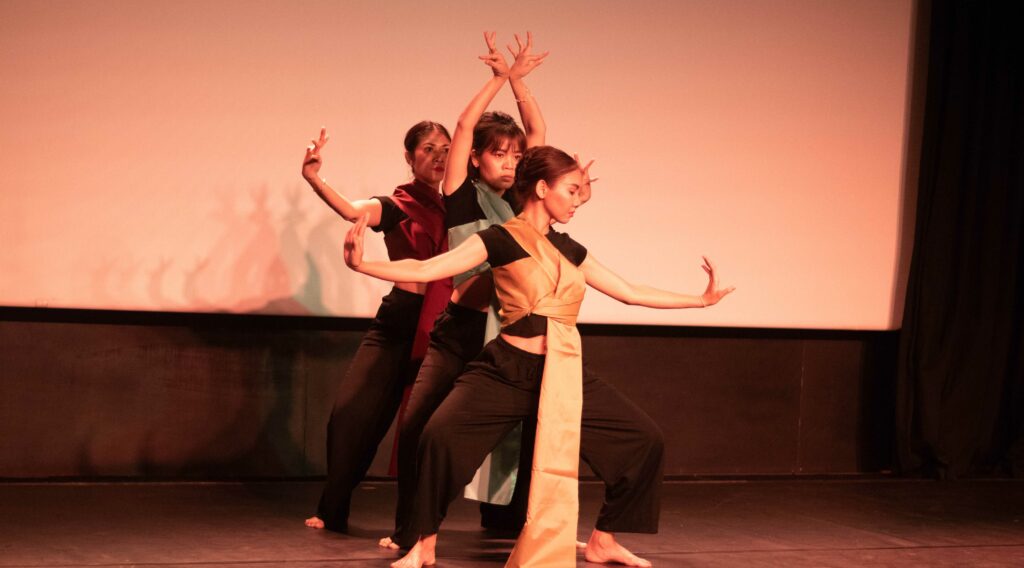
At nine years old, Pum Molyta joined the School of Fine Arts. For years, she stayed within the safety of classical forms. Shadow is her personal rebellion, confronting the fear of her past, stepping slowly but decisively toward the light. “I’ve always co-created dance pieces with others, but I never dared to create one on my own,” she said. “The workshop was an opportunity for me to build my capacity to become an independent artist.” The workshop helped her see herself anew. “I used to think I didn’t belong in the contemporary field. I felt more attuned to traditional dance. But this was my chance to start over,” she said.
Guided by what Molyta described as an “open and pressure-free” approach—“no books, no pens”—she began to experience a sense of freedom. “There were days I wanted to give up,” she admitted, “but Manou always reminded us: don’t overthink, just try.”
In one exercise, fellow trainee Chan Sopheap asked her to dance with the wall and use a flashlight to cast shadows. As she danced, something clicked. “I was happy with my movements. I felt like a character was coming alive inside me,” she said. “I kept thinking about my shadow on the wall, especially while preparing my pitch. I began to ask myself: What does that shadow represent?”
Her answer came clearly: “It was my weakness.” “It reflected the parts of me that weren’t so brave—my lack of confidence, my struggles with speaking up, my discomfort with networking.” And from that realization, she built her story.
Relationship — Kim Socheat’s Resistance for Visibility
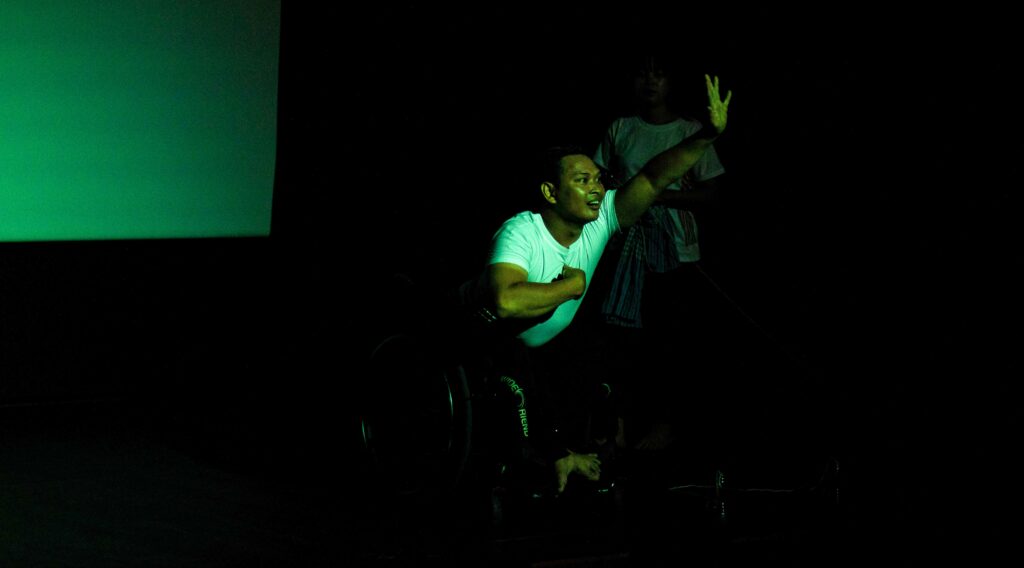
As a result of “living with a disability in a society that often looks away,” Kim Socheat has long struggled to find connection—not just in art, but in daily life. His piece, Relationship, is shaped by that pursuit.
Inspired by a childhood game which involved speaking through plastic cup telephones with his cousin, he builds a deeply symbolic dance around the yearning to be heard. “I try to communicate with others, only to realize that people don’t want to connect with me. I always wondered: what’s wrong with me?” Socheat recalled.
Socheat emphasized that he does not seek sympathy. His dance is an expression of his story and a reflection of reality. He attempts to connect to his audience using string and cups as metaphors for one-sided communication. The piece will evolve into a 25-minute duet, exploring his experience as a person with a disability, performed alongside another artist who uses sign language, expanding Socheat’s story.
The Chakto Program was transformative. “Before, others choreographed dances for me. Now, I direct them myself,” he said.
His pitch moved the room. “I almost cried, but I held it in,” he remembered. “I couldn’t believe the pitch was going smoothly.”
His message to the audience is simple: Relationships matter more than money, power, or status. “I hope people will build relationships with those of us living with disabilities,” he remarked. When you do, it makes us feel warm and safe—it tells us that society doesn’t reject us.”
A Barrier – What We Cannot Say, We Must Dance
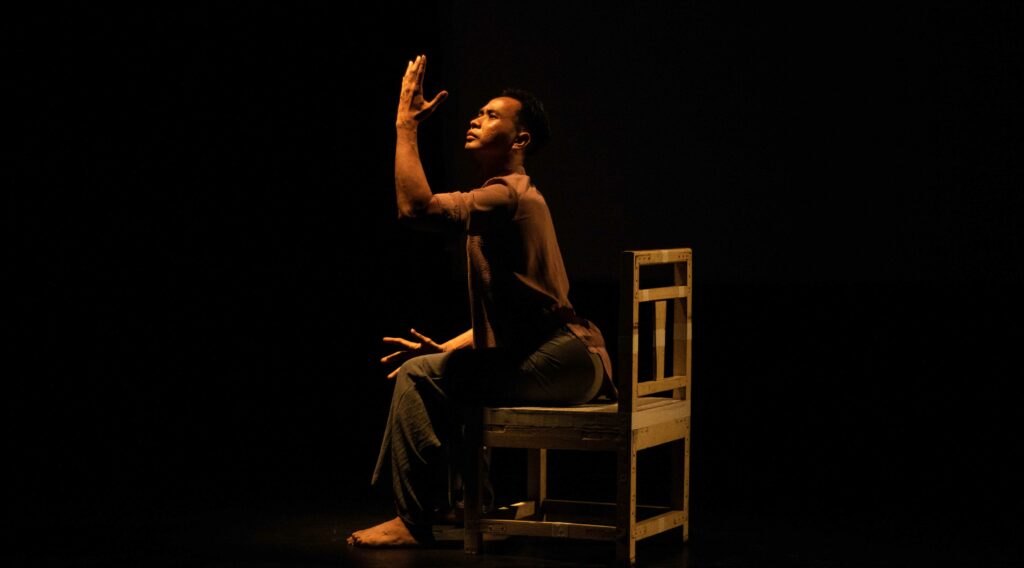
Vong Vannak, a trained choreographer with a circus background, created A Barrier from frustration and silence. “Since childhood, I hid my problems and tried to solve them alone,” he admitted.
He reconnected with Emmanuèle Phuon through the program, having worked on her earlier project as a costume designer. “We explored many new aspects of creating a dance piece—not only techniques for movement and breath, but also communication skills essential for working with a team or creative partner. We discovered unexpected goals and new directions in our creative journey,” he said.
Pitching an idea was unfamiliar to him, however. “As artists, we are often more equipped to perform our work than to describe it,” he elaborates. “This pitching experience taught us how to capture the attention of both audiences and judges, and how to invite them to understand our art on a deeper level. We also learned what makes a strong pitch, which helped me improve and develop my skills in presenting my work.”
When asked how he envisioned the end of the performance, he said, “relieved and relaxed.” He pictures the judges’ positive feedback, the audience’s applause, and the motivation to keep going.
The Chakto Program is part of a broader initiative by Institut français du Cambodge to support Cambodia’s creative industries, with key partnerships including Cambodian Living Arts, Anti-Archive, Kongchak Studio, and Sipar Cambodia. While the focus here is dance, the program is also nurturing writers, musicians, and filmmakers to bring about a new generation of artists in Cambodia.
